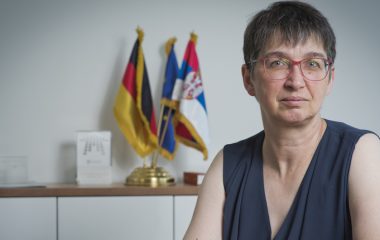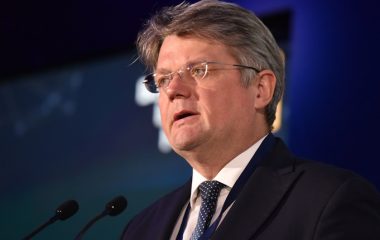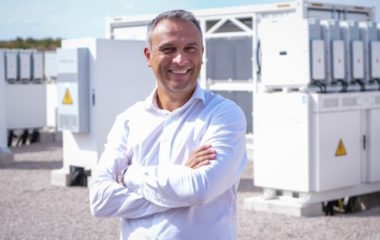
Photo: Aleksandar Pavlovic
The United Nations in Serbia is refurbishing its future headquarters to be energy efficient and even produce its own energy. Smart meters are installed to measure the consumption of electricity, heat and water, and significant technical remodelling is underway, says Irena Vojáčková-Sollorano. In an interview with Balkan Green Energy News, the UN Resident Coordinator and UNDP Resident Representative in the country pointed out that, for instance, designers are increasing light flow by putting glass walls at most of the floors. She stressed sustainability starts with every person’s commitment, and that all groups and communities in the society, all the way to the government and international bodies, are taking action according to the global consensus, defined in 17 Sustainable Development Goals.
Solar panels will be put on the flat roof of the UN building in New Belgrade. „Still, obtaining permits for that is a challenge and the organization is in talks with the city and the relevant ministry. This is very costly and we are working with the private sector and looking for reduced rates and even donations to see what other features or energy efficient technology we can get in,“ according to Vojáčková-Sollorano. The project is in development and the renovation will cost about USD 1 million (EUR 880,000), according to project calculations. „Since the energy that we consume will cost much less, the investments will be returning over time,“ she says. The building should be complete by mid-June and the energy equipment is planned for more upgrades.
A German national, Vojáčková-Sollorano has been appointed in Serbia in October 2013. She lead the country team’s response to the floods in 2014 together with the United Nations Development Programme and to the refugee and migrant crisis with UN Refugee Agency – UNHCR.
Prior to this appointment she has worked in different capacities for 28 years for the International Organization for Migration (IOM) in Asia, Europe and globally developing expertise. Vojáčková-Sollorano’s last appointment was as head of IOM’s Department for Migration Management (2010-2013) in Geneva. She holds a BA in history and political science from the University of Heidelberg, an MA in history, geography, and international law from the University of Vienna, and a diploma of the Diplomatic Academy in Vienna.
What is your view on Serbia’s role in the implementation of the 17 Sustainable Development Goals (SDGs) that the United Nations adopted last year? Which steps were taken by the government and what goals within the 2030 Agenda are the biggest challenge for the country?
Serbia was very active on the diplomatic level and in the preparation of over two years until the goals were identified. Through the UN country team we have involved the wider society in this debate, getting input through social media. We also worked with the civil society and the private sector. Especially the young people were interested, to make sure that there will be jobs and livelihood and that they will live in a stable and fair society. A point which was rather unique for Serbia and six other countries around the world was that youth wishes culture to be taken into consideration when discussing development – what is our future culture. We need a change in how we do things, that was the result. Culture is not only seen as going to a museum but how we behave and interact. It’s about taking responsibility.
Every person can take any of the goals and change something. A family or a school can take a sustainable development goal and work on it.
The young people want to take responsibility for their life. Every person can take any of the goals and change something. A family or a school can take a sustainable development goal and work on it.
Is it fair to say that Balkan countries have common challenges in sustainable development?
All countries have now subscribed to sustainable development. They will all be measured in the same way and report about the 17 goals – we no more have the divide between the developing and the developed world. While many goals are measured and achieved on a national level, many are cross border. Environmental protection and disaster risk reduction must be worked on with the neighbours, but so does economic development. Climate action and clean water and sanitation are some of the other SDGs which require regional action.
Participants in the conference on sustainable development held on April 4 in Serbia in the light of Agenda 2030 concluded that having transparent and efficient state institutions is crucial for reaching any of the goals, paired with achieving a wider social consensus. Who are the logical partners of the state in sustainable development policy?
Peace, justice and strong institutions are the goal number sixteen. Society is built on institutions: the government and the parlament, the civil society and the independent institutions all need a legal basis and protection and to be respected.
Diversification of sources and a wider utilization of renewables in the mix are necessary for sustainable energy development. The United Nations Development Programme is implementing the project ‘Reducing Barriers to Accelerate the Development of Biomass Markets in Serbia’. What are its results and where are the biggest headwinds?
Sustainable energy and the diversification of sources are a quest of the UN as a whole. In the country team we have many organizations that are supporting this from different angles. Serbia is just starting – we don’t have many companies or municipalities utilizing the great potential. The United Nations Environment Programme and the United Nations Development Programme are very active and have many projects with the government and local authorities. The Global Environment Facility (GEF) has several projects tapped especially by the Ministry of Mining and Energy together with UNDP. We are making public buildings energy efficient by measuring consumption and moving to reduce it.
We are looking at 20 municipalities to introduce efficiency measures and utilize biomass. We aim to attract up to USD 15 million into this area.
In another segment we are promoting biomass as renewable energy source. We are looking at 20 municipalities to introduce efficiency measures and utilize biomass. We aim to attract up to USD 15 million into this area.
There are many obstacles to get clean energy production established and that’s why it’s taking so long. With legal and administrative barriers, feed-in tariffs are yet to be implemented from an existing law. We would like to accelerate it by having capacity building with seminars and workshops for the administration in the ministry and municipalities. Awareness was low until now as well.
One of the segments of the project is the biomass e-trading platform. When is the system planned for launch?
The launch is expected by the end of the year as a result of cooperation between the Chamber of Commerce and Industry of Serbia and UNDP. We are increasing the understanding and knowledge of biomass suppliers and buyers and aim to establish standards.
UNDP is about empowerment, including emancipation through business skills. In your experience, particularly in the green energy segment, which mechanisms are effective in mobilizing people from marginalized groups?
The first step is education to empower people to take their own choices and not be dependent on other people to interpret to them what they should do. Besides the work of Unicef with the Ministry of Education, UNDP is looking at the context of municipalities so that marginalized groups have access to health, education and jobs. We have built a recycling centre near Novi Pazar and made sure that there is water and sanitation in the nearby settlement and also jobs for the people living there. The facility was handed over to the local waste management utility. We are doing it to show municipalities what they can do themselves. UNDP is not here to take care of each individual, this is the responsibility of the authorities. We are just showing them what can be done.
After the floods of 2014 we have implemented many measures on the municipal level, like building barriers against torrential floods. We are making sure that the companies doing the work are from the area to generate employment and increase skills, and also the awareness of the environment.
What measures on the local scale are needed in the improvement of energy management in municipalities and cities and where does UNDP step in?
First of all it is measuring energy use, comparing data and looking at examples of how consumption can be reduced. UNDP is assisting municipalities with measurements and looking at individual solutions, depending on whether this is a mountainous area, if there’s forest or it has rivers. So we are also helping to write projects and there is a lot of capacity building to be done so that municipalities can avail of the funds that are out there. But they need proper documentation before they can apply.
And is the capacity of expertise on the ground sufficient for the endeavour? What is the scale of savings that are expected?
Expertise is out there and it needs to be tapped. We help with matching. UNDP is putting together research on Kolubara river basin, about water flows and what needs to be done so that flooding is controlled. It takes high-level analysis by many experts and companies. We brought all of them together and they are writing a study.
The region suffered from extreme floods in 2014 and the events put in the spotlight the urgency of disaster management and works to adapt to climate change. How much has been done in the meantime and how did the UN contribute?
This was a strong cooperation with the authorities which emerged overnight. When we received the letter of request for help, virtually within one day we had relief coming in, but also experts which were evaluating the situation as it was happening and looking at measures for prevention.
Environmental protection and disaster risk reduction must be worked on with the neighbours, but so does economic development. Climate action and clean water and sanitation are some of the other SDGs which require regional action.
Last year the Sendai Declaration was signed in Japan about disaster risk reduction on a global scale. Serbia was strongly represented and participated in establishing the standards to produce the document. It was one of the first countries to sign and ratify it. We have worked with the Government of Serbia on this and authorities were fast in looking at how to implement the new measures. The legislation should be adopted soon. We have worked on an action plan for the next five years to establish a disaster risk reduction system.
Last year Serbia was the first of the candidates for membership in the European Union to announce its measures to reduce greenhouse emissions. What is its position in sustainable development?
Serbia has set a baseline and I think the goals are achievable, but action has to start now. Carbon emissions need to be reduced drastically, through renewable energy use and other measures, but the state needs to be much more active. The European Union accession process is also coming with different measures, but the Paris Declaration is about global goals. We think this makes double efforts with requirements for Serbia to do the right thing, but it has to begin very fast.
“Women are often the primary managers of energy in their households and communities and so can be powerful agents of change in the transition to sustainable, clean, green energy,” UN general secretary Ban Ki-moon said at the World Future Energy Summit in Abu Dhabi in January. What are the examples of gender mainstreaming in UN’s projects, particularly in the field of climate change and sustainable energy development in Serbia and the region?
In all our projects gender mainstreaming is a crosscutting issue. Whatever we do, we make sure the needs and energy of both genders are equally represented. In disaster risk reduction measures like training of rescue teams, we get women involved, as earlier they weren’t participating. UNDP has a project about including women in law enforcement. The one about energy efficiency is on a municipal level. Education is very important on this level and in our capacity building and awareness raising we are aiming that at least 50% of participants are women.








